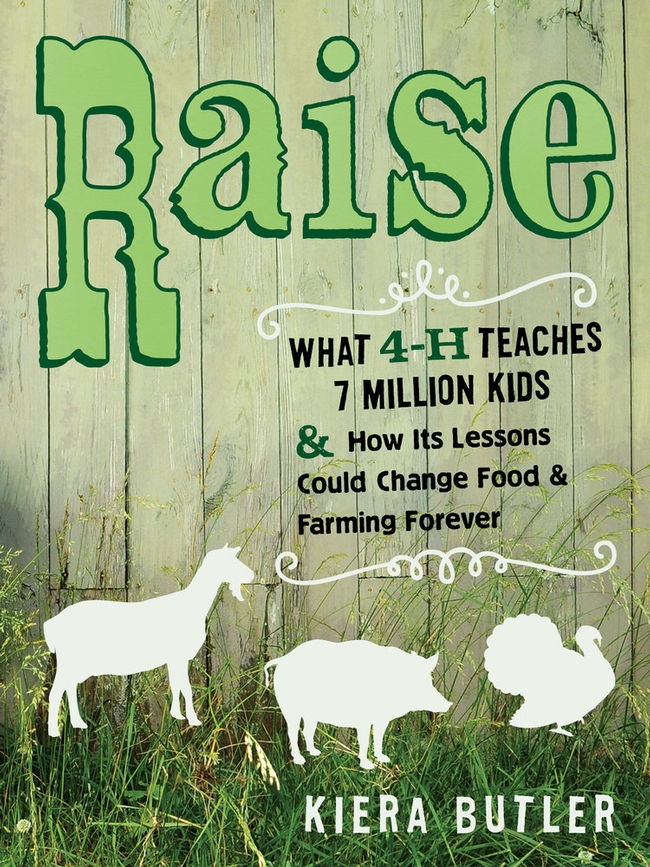
Butler was city-raised back East and became enamored by the local food movement, urban agriculture and farmers markets in California's Bay Area. She first ventured to a county fair at the age of 31. When she did, she was enchanted by girls in the livestock barn dressed in snow-white uniforms tending goats.
“When I first learned about 4-H, I thought I had found a genuine American relic, a throwback to a simpler time,” Butler wrote. “I couldn't have been more wrong.”
Butler forged relationships with a handful of suburban California 4-H members raising livestock, though she noted in the book that animal husbandry is just one aspect of today's 4-H program.

Butler visited the homes of 4-H members and attended their meetings. She trailed 4-H'ers as they fed, watered, and walked goats, sheep and pigs. She sat through long, hot competitions and auctions at county fairs. She befriended the parents who were cheering their children from the sidelines.
“The kids were fascinating individuals,” Butler said. “They were regular teenagers in addition to being experts in showing goats, sheep or pigs. I wanted to get their personalities across, how they looked and what motivated them, rather than just their participation in a club.”
Allison Keaney, 4-H program representative for UC Cooperative Extension in Marin County, said she enjoyed the book.
“I appreciate that she (Butler) has gotten into the essence of our program, all the wonderful things that come out of 4-H: communication skills, interpersonal skills, managerial skills,” Keaney said. “She touches on what 4-H is providing to young people that they are not getting at school.”
In the book, Butler recounted the stories of two 4-H'ers who were excelling in their 4-H projects, but not doing as well in their structured school settings. One is Anthony, who is struggling with math class, but managing quite well when calculating the amount of food his animals need based on their weight.

“But that version of Allison is hard to reconcile with the one that I am getting to know – the confident, knowledgeable and outgoing 4-H Allison,” Butler wrote.
Keaney said she recommends the book for 4-H leaders, classroom teachers and after-school program facilitators.
The UC Agriculture and Natural Resources program representative for 4-H animal science education, Sarah Watkins, was quoted several times in the book. Watkins said when she spoke to Butler, she didn't know her comments would be published in a book, but she is pleased with the result.
“She puts 4-H in a very nice light and was able to connect it back to UC,” Watkins said. “Even people who are involved in 4-H at the club level don't always understand that connection.”
Watkins recommends the book for young parents, so they will learn about opportunities for their children.
“It's a great read for anybody to fully understand the depth of modern 4-H,” Watkins said.
UCCE 4-H Youth Development advisor Marcel Horowitz saw Butler's book mentioned in Sunset Magazine. She read the book and found it to be an excellent introduction to the animal side of 4-H. She was also intrigued with the chapter about 4-H in Ghana, Africa.
Butler said she received a grant to travel to Africa, where she met 4-H leaders and members, including a young man in a small community who received hybrid maize seed from DuPont. The superiority of the crop amazed local subsistence farmers, but gave rise to new problems. The seed cost 10 times more than their traditional seed, and, because it is a hybrid, cannot be collected and held over to plant the following year.

“Please tell DuPoint to give us more seeds; we don't have wigs to fly,” Butler quoted a small town science teacher in Ghana. “We are praying that DuPoint will continue to provide for us.”
Horowitz said she was interested in the ethical dilemma.
“How do you fund 4-H projects without the conflict or bias of the fund source?” Horowitz said.
The Ghana chapter is a short departure for the book, which is firmly rooted in Northern California 4-H animal programs and Butler's discovery that 4-H isn't just for children growing up on farms. 4-H is a way to learn-by-doing in the areas of science, citizenship and healthy living.
“When I try to imagine my original ideal 4-H'er now, I find that I can't do it,” Butler concluded in the book's Afterword. “She has been replaced by all the actual 4-H'ers I know. Luckily for me, they're much more interesting.”
The book is available from University of California Press, Amazon.com and other outlets.
An initiative to maintain and enhance healthy families and communities is part of the UC Division of Agriculture and Natural Resources Strategic Vision 2025.